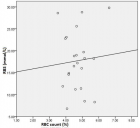Abstract
Research Article
Nitrogen Fixation and Yield of Common Bean Varieties in Response to Shade and Inoculation of Common Bean
Selamawit Assegid* and Girma Abera
Published: 29 December, 2023 | Volume 7 - Issue 3 | Pages: 157-162
Light is not only a primary energy source, but it is also one of the environmental factors that affect plant growth and development. Common bean (Phaseolus vulgaris L.) is commonly produced in association with maize as subordinate intercrops in the Sidama region. Under such a production system, the shade effect may limit the photosynthetic and nitrogen-fixing capacity of common beans. The objective of the current study was to assess how inoculation and shade affect the ability to fix nitrogen and yield components of common beans. Three common bean varieties (Hawassa dume, Nassir, and Ibbado), two shade levels (open and 25% shade) as well as two levels of inoculation (uninoculated and inoculated) were used for these purposes. The experiment was set up in factorial randomized complete block design (RCBD) in four replications. In this experiment, Rhizobium inoculation and shade significantly (p < 0.05) affected the number of pods plant-1 and the number of seeds pod-1. The inoculated treatment produced the maximum number of pods plant-1 (14.02) and the lowest number of pods plant-1 (10.95) was obtained from uninoculated treatments. The results also showed that the inoculated Hawassa dume variety from the open treatments derived the maximum percentage of N from N2 fixation, whereas the non-inoculated Ibbado variety from the 25% shade treatments derived the lowest percentage of N. Common bean grown on full light had significantly greater N content than shade.
Read Full Article HTML DOI: 10.29328/journal.jpsp.1001122 Cite this Article Read Full Article PDF
Keywords:
Inoculation; Light; Nitrogen fixation; Open; Shade
References
- Central Statistical Agency (CSA).The Federal Democratic Republic of Ethiopia, Agricultural Sample Survey 2014/2015 Volume V, Report on area, production and farm management practice of belg season crops for private peasant holdings 2015. Statistical Bulletin 578. Ethiopia.
- Legese D, Gure K, Teshale A. Production and marketing of white pea Beans in Rift Valley Ethiopia. A sub-sector analysis CRS Ethiopia program. Addis Ababa. 2006.
- Bloom AJ. Energetics of Nitrogen Acquisition, Annual Plant Reviews, 2011; 42: 63-81.
- Carlsson G, Palmborg C, Jumpponen A, Scherer-Lorenzen M, Högberg P, Huss Danell K. N2 fixation in three perennial Trifoliumspecies in experimental grasslands of varied plant species richness and composition. Plant Ecol 2009. 205: 87–104.
- Jensen E. Grain yield, symbiotic N2-fixation and interspecific competition for inorganic N in pea-barley intercrops. Plant Soil. 1996; 182: 25–38.
- International Food Policy Research Institute (2010).
- National Meteorological Agency (2015). Hawassa branch.
- Unkovich M, Herridge D, Peoples M, Cadisch G, Boddey B, Giller K, Alves B, Chalk P. Measuring plant-associated nitrogen fixation in agricultural systems. ACIAR. Monographno 136, Canbberra. 2008.
- Rhoades JD. Soil Testing. In: Page A, Miller RM, Keeney DR. Eds., Methods of Soil Analysis, Part 2, 2nd Edition. Am Soc Agron Madison. 1982; 16-21.
- Walkley A, Blank IA. An example of the digestion method for determining soil organic matter and a proposed modification of the chromic acid titration method. Soil Sci. 1934; 34:29-38.
- Bremner JM, Mulvaney CS. Methods of Soil Analysis, Part 2 Chemical and Microbiological Properties. 1982; 595-624.
- Olsen SR, Cole CV, Wantanabe FS, Dean LA. Estimation of available phosphorous in soils by extraction with sodium bicarbonate, U.S. Department of Agriculture circular 939. U.S.D.A, Washington DC. 1954; 23.
- Jackson M. Soil chemical analysis. New Jersey, Prentice Hall. 1958; 219.
- Bouyoucos GJ. Hydrometer method improved for making particle size analysis of soils. Agron J. 1962; 54:464-465.
- SAS Institute Inc..SAS User’s Guide, Statistics Version 9.0 ed. SAS Institute, 2002 Cary, NC, USA.
- Kubota A, Kent H, Jorge B. Effect of fertilizer-N application and seed coating with rhizobial inoculants on soybean yield in eastern Paraguay. Revista Brasileira de Ciência do Solo. 2008;32: 1627-1633.
- El-Wakeil NE, El-Sebai TN. Role of Biofertilizer on Faba bean growth, yield, and its effect on bean aphid and the Associated Predators. Res J Agric Biol Sci. 2007; 3(6):800-807.
- Liu W, Deng Y, Hussain S, Zou J, Yuan J, Luo L, Yang C, Yuan X, Yang W. Relationship between cellulose accumulation and lodging resistance in the stem of relay intercropped soybean [glycine max (l.) merr.]. –Field Crops Res. 2016; 196: 261-267.
- Togay N, Togay Y, Cimrin KM, Turan M. Effect of Rhizobium inoculation, sulfur and phosphorous application on yield, yield component, and nutrient uptake in chickpea (Cicerarientinum L.). Afr J Biotechnol. 2008; 7(6):776-782.
- Bhuiyan MMH, Rahman MM, Afroze F, Sutradhar GNC, Bhuiyan MSI. Effect of phosphorus, molybdenum, and Rhizobium inoculation on growth and nodulation of mung bean Scientific Officer, RARS, Hathazari, Chittagong. J Soil Nature. 2008; 2 (2): 25-30.
- Sharma S, Upadhyay RG, Sharma CR. Effect of Rhizobium inoculation and nitrogen on growth, dry matter accumulation, and yield of black gram (Vignamungo). Legume Res. 2000; 23(1): 64-66.
- Sidique KHM, Belford RK, Tannant D. Root: shoot ratio of old and modern, tall and semi-dwarf wheat in Mediterranean environment. Plant Soil. 1990; 121:89-98.
- Malik A, Hassan F, Waheed A, Qadir G, Asghar R. Interactive effects of irrigation and phosphorus on green gram (Vigna radiata L.). Pak J Biotechnol. 2006; 38(4):119-1126.
- Dereje A. Effect of Bradyrhizobium japonicium inoculation and N fertilizer on nodulation, protein content, yield and yield components of soybean (Glycin max L.) in hawassa. MSc thesis. Hawassa University. Ethiopia. 2007.
- Khalid MHB, Raza MA, YU HQ, Sun FA, Zhang YY, Lu FZ, SI L, Iqbal N, Khan I, Fu FL, Li WC. Effect of shade treatments on morphology, photosynthetic and chlorophyll fluorescence characteristics of soybeans Sichuan Agricultural University, NO. 211, Huimin Road, Wenjiang District, Chengdu, Sichuan. 2019; 611130,
- Muhammad AK. Production efficiency of chickpea (Cicerarietinum L.) as affected by inoculation, phosphorus levels, and intercropping. Ph.D. (Agriculture) Thesis, University of Agricultural Sciences, Faisalabad. 2002; 48-79.
- Sajid M, Rab A, Wahid F, Shah SNM, Jan I, Khan MA, Hussain SA, Khan MA, Iqbal Z. Influence of Rhizobium inoculation on growth and yield of groundnut cultivars. Sarhad J Agric. 2011; 27(4):574576.
- Abbasi MK, Majeed A, Sadiq A, Khan SR. Application of Bradyrhizobium japonicum and phosphorus fertilization on growth, yield, and nodulation of soybean in the sub-humid hilly region of Azad Jammu and Kashmir. Plant Prod Sci. 2008; 58: 368-376.
- Wu Y, Gong W, Yang F, Wang X, Yong T, Yang W. Responses to shade and subsequent recovery of soya bean in maize-soya bean relay strip intercropping. Plant Prod Sci. 2016; 19: 206-214.
- Iqbal N, Hussain S, Ahmed Z, Yang F, Wang X, Liu W, Yong T, Du J, Shu K, Yang W. Comparative analysis of maize-soybean strip intercropping systems. A review. Plant Prod Sci. 2018. doi.org/10.1080/1343943X.2018.1541137.
- Yang F, Liao D, Wu X, Gao R, Fan Y, Raza MA, Wang X, Yong T, Liu W, Liu J. Effect of aboveground and belowground interactions on the intercrop yields in maize-soybean relay intercropping systems. Field Crops Res. 2017; 203: 16-23.
- Kamara AY, Abaidoo R, Kwari J, Omoigui L. Influence of phosphorus application on growth and yield of soybean genotypes in the tropical savannas of northeast Nigeria. Archives of Agronomy and Soil Science. 2007; 53; 5: 539552.
- Kawaka F, Dida MM, Opala PA, Ombori O, Maingi J, Osoro N, Muthini M, Amoding A, Mukaminega D, Muoma J. Symbiotic efficiency of native rhizobia nodulating common bean (Phaseolus vulgaris L.) in soils of western Kenya. Int Sch Res Not. 2014; 2014: 1–8. https://doi.org/10.1155/2014/258497
- Elkoca E, Turan M, Donmez MF. Effects of single, dual, and triple inoculations with Bacillus subtilis, Bacillus megaterium and Rhizobium leguminosarum bv. phaseoli on nodulation, nutrient uptake, yield, and yield parameters of common bean (Phaseeolus vulgaris cv. ‘Elkoca-05’). J Plant Nutr. 2010; 33(14):2104–2119. https:// doi.org/10.1080/01904167.2010.519084
- Zafar-Allah M, Sifi B, L 'Taief B, El Aouni M, Drevon J. Rhizobial inoculation and P fertilization response in common bean (Phaseolus vulgaris) under glasshouse and field conditions. Exp Agric. 2007; 43(01): 67–77. https://doi.org/10.1017/S0014479706004236.
- Abi-Ghanem R, Carpenter-Boggs L, Smith JL.Cultivar effects on nitrogen fixation in peas and lentils. Bio Fertil Soils 2011; 47:115-120.
- Hardarson G. Genotypic variation in biological nitrogen fixation by common bean. Plant and Soil. 1993; 152(1): 59-70. http://dx.doi.org/10.1007/BF00016333.
- Nleya T, Walley F, Vanderbeng A. Nodulation, seed yield and dinitrogen fixation in determinate and indeterminate common bean cultivars. Ann Rep Bean Improv Coop. 2002; 45: 54–55.
- Neves MC, Hungria M. The physiology of nitrogen fixation in tropical grain legumes. Crit Rev Plant Sci. 1987; 3: 269–321.
Figures:
Similar Articles
-
HBV: Genomic Structure, HBVsAg Isolation and innovative Virotherapy Initiation in the Middle EastAboul-Ata E Aboul-Ata*,Essam M Janahi,I M El-Kalamawy,Kathleen Hefferon,Amal Mahmoud. HBV: Genomic Structure, HBVsAg Isolation and innovative Virotherapy Initiation in the Middle East . . 2017 doi: 10.29328/journal.jpsp.1001007; 1: 059-061
-
Detection of Clavibacter michiganensis subsp. michiganensis in tomato and chili seeds and farming area of Sinaloa, MexicoRuiz Alvarado Cristina*,Soto Ortiz Roberto,Cervantes Diaz Lourdes,Nuñez Ramirez Fidel,Celaya-Michel Hernán,Rueda Puente Edgar O. Detection of Clavibacter michiganensis subsp. michiganensis in tomato and chili seeds and farming area of Sinaloa, Mexico. . 2018 doi: 10.29328/journal.jpsp.1001019; 2: 044-054
-
Bacillus amyloliquefaciens as a plant growth promoting bacteria with the interaction with of grass salt Distichlis palmeri (Vasey) under field conditions, in desert of Sonora, MexicoRueda Puente Edgar O*,Ruiz Alvarado Cristina,Jesús Borboa Flores,Victor Cardenas Salazar,Soto Ortiz Roberto,Lourdes Díaz Cervantes. Bacillus amyloliquefaciens as a plant growth promoting bacteria with the interaction with of grass salt Distichlis palmeri (Vasey) under field conditions, in desert of Sonora, Mexico. . 2018 doi: 10.29328/journal.jpsp.1001021; 2: 059-067
-
Antiviral RNAi mediated Plant defense versus its suppression by virusesSunil Kumar Mukherjee*,Dinesh Gupta. Antiviral RNAi mediated Plant defense versus its suppression by viruses. . 2019 doi: 10.29328/journal.jpsp.1001025; 3: 001-008
-
Cloning and Characterization of a Pseudo-Response Regulator 7 (PRR7) Gene from Medicago Sativa Involved In Regulating the Circadian ClockWeifeng Nian*,Yilin Shen. Cloning and Characterization of a Pseudo-Response Regulator 7 (PRR7) Gene from Medicago Sativa Involved In Regulating the Circadian Clock. . 2019 doi: 10.29328/journal.jpsp.1001032; 3: 056-061
-
Serological and molecular characterization of two seed born cowpea mosaic Comovirus isolates affecting cowpea plants (Vigna unguiculata L.) in northern EgyptMahmoud Hamdy Abd El-Aziz*,Hosny Aly Younes. Serological and molecular characterization of two seed born cowpea mosaic Comovirus isolates affecting cowpea plants (Vigna unguiculata L.) in northern Egypt. . 2019 doi: 10.29328/journal.jpsp.1001037; 3: 086-094
-
Intensive fruit orchards cultivationWaleed Fouad Abobatta*. Intensive fruit orchards cultivation. . 2021 doi: 10.29328/journal.jpsp.1001064; 5: 072-075
-
Photocatalytic degradation of organic pollutants in the presence of selected transition metal nanoparticles: reviewTigabu Bekele Mekonnen*. Photocatalytic degradation of organic pollutants in the presence of selected transition metal nanoparticles: review. . 2022 doi: 10.29328/journal.jpsp.1001084; 6: 115-125
-
Flashes of UV-C light are perceived by UVR8, the photoreceptor of UV-B lightJawad Aarrouf*,Douae Ben Hdech,Alice Diot,Isabelle Bornard,Lauri Félicie,Laurent Urban*. Flashes of UV-C light are perceived by UVR8, the photoreceptor of UV-B light. . 2022 doi: 10.29328/journal.jpsp.1001089; 6: 151-153
-
Nitrogen Fixation and Yield of Common Bean Varieties in Response to Shade and Inoculation of Common BeanSelamawit Assegid*,Girma Abera. Nitrogen Fixation and Yield of Common Bean Varieties in Response to Shade and Inoculation of Common Bean. . 2023 doi: 10.29328/journal.jpsp.1001122; 7: 157-162
Recently Viewed
-
Overview on liquid chromatography and its greener chemistry applicationAdel E Ibrahim,Magda Elhenawee,Hanaa Saleh,Mahmoud M Sebaiy*. Overview on liquid chromatography and its greener chemistry application. Ann Adv Chem. 2021: doi: 10.29328/journal.aac.1001023; 5: 004-012
-
COPD and low plasma vitamin D levels: Correlation or causality?Luca Gallelli*, Erika Cione,Stefania Zampogna, Gino Scalone. COPD and low plasma vitamin D levels: Correlation or causality? . J Pulmonol Respir Res. 2018: doi: 10.29328/journal.jprr.1001008; 2: 011-012
-
Environmental Factors Affecting the Concentration of DNA in Blood and Saliva Stains: A ReviewDivya Khorwal*, GK Mathur, Umema Ahmed, SS Daga. Environmental Factors Affecting the Concentration of DNA in Blood and Saliva Stains: A Review. J Forensic Sci Res. 2024: doi: 10.29328/journal.jfsr.1001057; 8: 009-015
-
Markov Chains of Molecular Processes of Biochemical MaterialsOrchidea Maria Lecian*. Markov Chains of Molecular Processes of Biochemical Materials. Int J Phys Res Appl. 2024: doi: 10.29328/journal.ijpra.1001076; 7: 001-005
-
Generation of Curved Spacetime in Quantum FieldSarfraj Khan*. Generation of Curved Spacetime in Quantum Field. Int J Phys Res Appl. 2024: doi: 10.29328/journal.ijpra.1001077; 7: 006-009
Most Viewed
-
Evaluation of Biostimulants Based on Recovered Protein Hydrolysates from Animal By-products as Plant Growth EnhancersH Pérez-Aguilar*, M Lacruz-Asaro, F Arán-Ais. Evaluation of Biostimulants Based on Recovered Protein Hydrolysates from Animal By-products as Plant Growth Enhancers. J Plant Sci Phytopathol. 2023 doi: 10.29328/journal.jpsp.1001104; 7: 042-047
-
Sinonasal Myxoma Extending into the Orbit in a 4-Year Old: A Case PresentationJulian A Purrinos*, Ramzi Younis. Sinonasal Myxoma Extending into the Orbit in a 4-Year Old: A Case Presentation. Arch Case Rep. 2024 doi: 10.29328/journal.acr.1001099; 8: 075-077
-
Feasibility study of magnetic sensing for detecting single-neuron action potentialsDenis Tonini,Kai Wu,Renata Saha,Jian-Ping Wang*. Feasibility study of magnetic sensing for detecting single-neuron action potentials. Ann Biomed Sci Eng. 2022 doi: 10.29328/journal.abse.1001018; 6: 019-029
-
Pediatric Dysgerminoma: Unveiling a Rare Ovarian TumorFaten Limaiem*, Khalil Saffar, Ahmed Halouani. Pediatric Dysgerminoma: Unveiling a Rare Ovarian Tumor. Arch Case Rep. 2024 doi: 10.29328/journal.acr.1001087; 8: 010-013
-
Physical activity can change the physiological and psychological circumstances during COVID-19 pandemic: A narrative reviewKhashayar Maroufi*. Physical activity can change the physiological and psychological circumstances during COVID-19 pandemic: A narrative review. J Sports Med Ther. 2021 doi: 10.29328/journal.jsmt.1001051; 6: 001-007

HSPI: We're glad you're here. Please click "create a new Query" if you are a new visitor to our website and need further information from us.
If you are already a member of our network and need to keep track of any developments regarding a question you have already submitted, click "take me to my Query."















































































































































